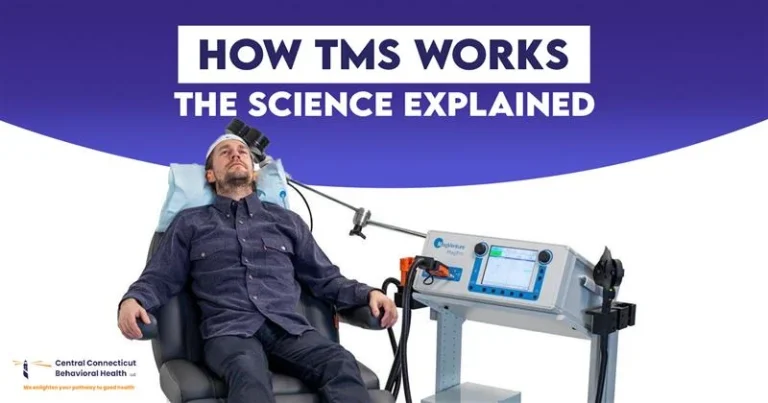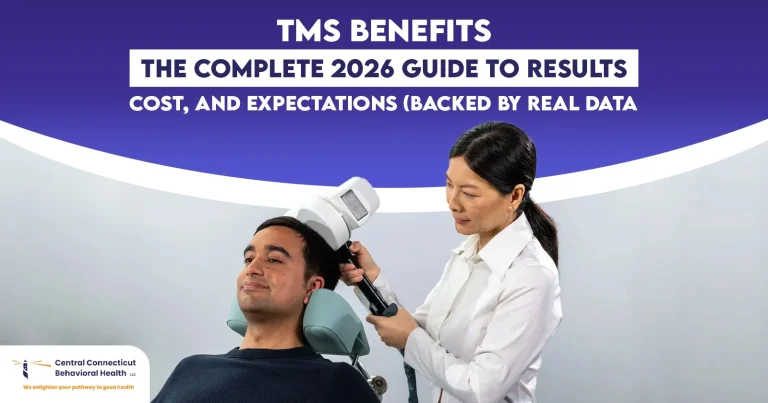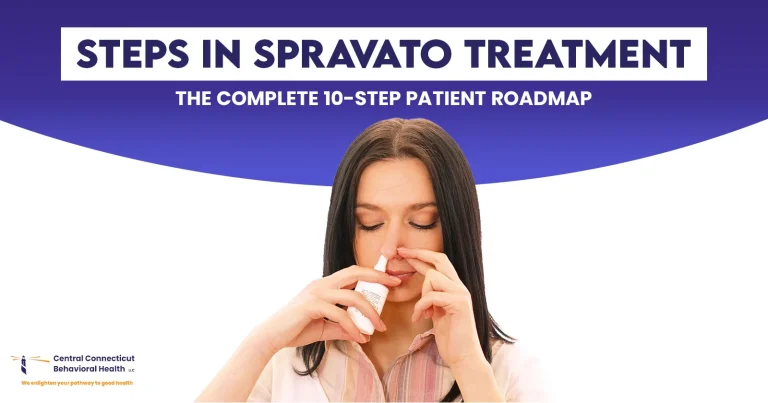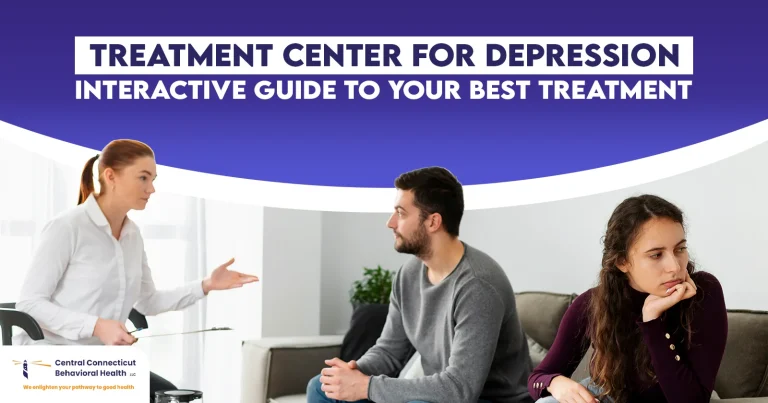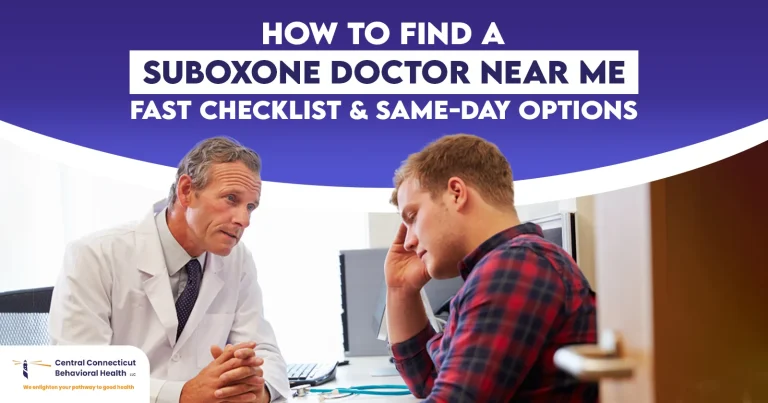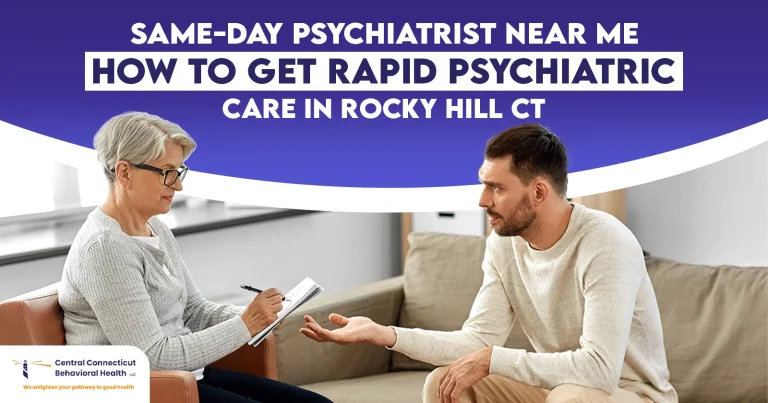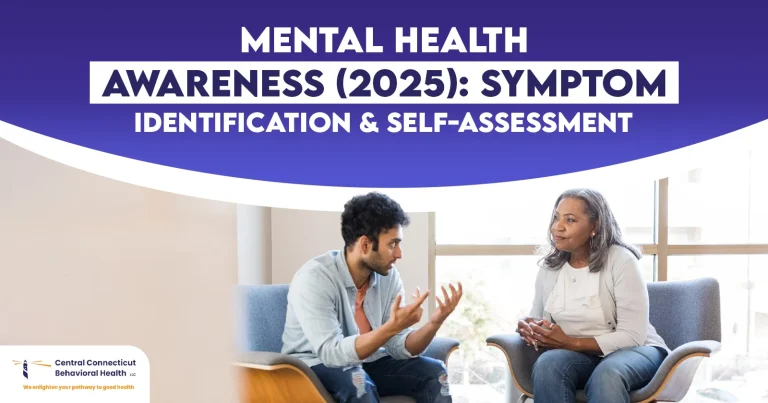Transcranial Magnetic stimulation therapy (TMS) is a promising and non-invasive treatment for depression and obsessive-compulsive disorder (OCD). But a common question asked by patients is: “What is TMS?”
This blog from Central Connecticut Behavioral Health explores the clinical effectiveness, academic success, side effects, and practical considerations associated with TMS therapy. Backed by clinical data and experience, the purpose is to clarify what patients can expect from this non-invasive neuromodulation treatment.
what is TMS?
-
Understanding what is TMS and How TMS Therapy Works
Transcranial magnetic stimulation uses magnetic fields to stimulate specific brain regions involved in my mood regulations.
- The difference of electroconvulsive therapy (ECT), does not require anesthesia and does not cause seizures.
- The device is sent to prefrontal cortex, an area associated with depression and anxiety.
- The sessions usually last 30 to 40 minutes, five times a week. Patients remain awake and alert across the procedure.
This process imprints the nerve limit, to help regulate emotional responses, a major reason why TMS for depression shows positive outcomes in many clinical studies.
-
TMS for Depression and OCD: Who Can Benefit?
TMS therapy is often recommended for patients who have not responded well to traditional antipsychotics or psychotherapy.
- TMS therapy for depression may reduce symptoms in the treatment-resistant cases.
- TMS therapy for OCD helps handle repeated thought patterns and convulsive behavior.
- Recent studies show that about 60-70% of patients have been seen with significant improvement, while 30-40% have achieved complete success after getting TMS treatment.
-
Clinical Effectiveness and Success Rate
When analyzing TMS therapy effectiveness, clinical evidence and long-term follow-ups constantly improves its success.
- The average TMS therapy success rate is between 50 and 65%, according to the gravity and degree of illness.
- The sustainable improvement can last up to a year with maintenance sessions.
- Compared to medications, TMS produces fewer side effects in systemic circulation and best completion of the patient-compliance.
-
Pros and Cons of TMS Therapy
Before you choose a treatment, it is important to consider the TMS therapy pros and cons..
Pros:
- Non-invasive, anesthesia is not required
- Reduced or no systemic side effects at all
- Appropriate for depression that is resistant to treatment
- Fast recovery time, no downtime
Cons:
- Requires multiple sessions daily for 4 to 6 weeks
- Can cause headache or scalp discomfort
- Insurance coverage can change
Although no therapy is completely without risk, benefits of TMS treatment often exceeds to the patients who do not respond to medication.
-
What is TMS vs. antidepressants?
The debate between what is TMS vs antidepressants centers on long-term outcomes and tolerability.
- Antidepressants indirectly influence the brain chemistry and can take weeks to produce their effects.
- TMS directly stimulate the brain circuits, produce faster, intended results.
- Patients who stop taking antidepressants due to side effects often find TMS to be a safer alternative.
For some, a combined TMS approach and medication under medical supervision can give optimal results.
-
Side Effects and Safety Considerations
One of the most secured aspects of TMS therapy is its strong security profile.
Common but mild TMS therapy side effects include:
- Slight scalp discomfort
- Mild headache or tingling sensation
- Fatigue after sessions
Session responses are extremely rare and the prove is approved by FDA, confirming their security for clinical use.
-
Duration, Coverage, and What to Expect
Patients often wonder about TMS therapy duration and insurance coverage.
- A standard course involves 20–30 sessions spread over 4–6 weeks.
- Some insurance plans provide TMS therapy insurance coverage, especially when previous treatments failed.
- Promising results can be seen within 2–3 weeks, though this can vary.
- During each session, the patient gets smooth while a magnetic coil is positioned on the scalp.
- There is no pain, only a mild inception sensation.
Understanding of what to expect during TMS Therapy session helps to reduce anxiety and improve general experience.
Clinical Evidence Review
- FDA approved for depression in 2008 and for OCD in 2018.
- Remission rate: 30–40% (after 4–6 weeks of therapy).
- Maintenance treatment helps prevent relapse.
- Finding a balance between the medication and TMS therapy
In many clinical cases, healthcare providers for improving mental health, advices to combine TMS therapy with low dosage medication or psychotherapy. This balanced treatment approach can improve the results and reduce relapse risk. For patients with a partial response on antipsychotics, addition of TMS can make a measurable change in mood and cognitive functions.
How does TMS work?
- The best answers to questions like “How does TMS work?” or “what is TMS?” is the clinical data and patient results by showing their reliability in treatment-resistant condition.
- Average TMS therapy success rate ranges between 60 and 70%, with about one-third of the patients with a structured treatment.
- These findings support TMS as a clinically valid intervention, non-invasive, linking with a comprehensive psychiatric care that is offered at Central CT Behavioral Health.
Final Words
So, what is TMS and how does TMS work?
Based on clinical evidence and patient experiences, it suggest that this really works especially for the treatment-resistant depression and OCD complex. Its non-invasive nature, security profile and effectiveness has made it the most reliable choice for people who seek alternatives of traditional medication.
Always search for TMS near me or the best TMS clinic near me to consult a psychiatrist or neurologist to assess your specific case and decide the most appropriate plan adjusted to your needs. If you or any loved one is considering TMS therapy, consult a mental health provider at Central Connecticut Behavioral Health for a custom assessment plan and treatment.
FAQs: what is TMS?
Q1. Is there any TMS for depression?
Yes, many studies have shown a significant improvement in depressive symptoms, especially in patients who do not respond to medication.
Q2. How long does TMS therapy take to show results?
Most patients begin to note the changes after 2 to 3 weeks of regular sessions.
Q3. Is TMS therapy FDA approved?
Yes, it is approved by FDA for depression and OCD, confirming its clinical security and effectiveness.
Q4. What are the TMS therapy pros and cons?
Pros: non-invasive and free of any drug
Cons: multiple sessions and little temporary discomfort.



